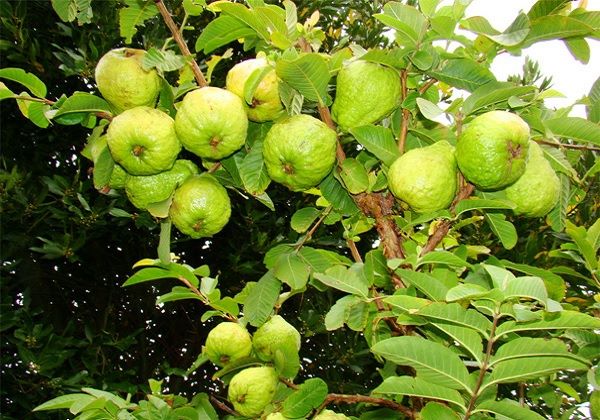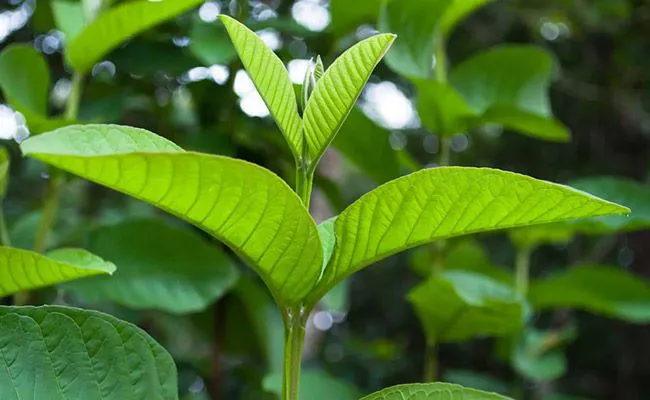Guava is a nutritious food, with many valuable uses for health. Not only that, parts of the guava tree are also used as medicine.
1. Characteristics of guava trees
Guava trees are also called iron, pomegranate, guajava. Scientific name Psidium guyjava L. (P. pomiferum L. Psidium Pyriferum L.). Belongs to the family Myriaceae.
Guava is a medium-sized tree, about 3-5m high, with small branches that are square. The leaves grow opposite, have short petioles, are oval, smooth or slightly hairy on the upper surface, and have fine hairs on the lower surface, with intact blades, and when illuminated, the essential oil sacs can be seen.
The flowers are white, growing singly in the leaf axils. The fruit is a berry with a thick mid-shell, the shape varies depending on the species, and at the tip of the fruit there is a scar of the calyx. There are many seeds, kidney-shaped, uneven, and slightly brown in color.
The guava tree originates from tropical America, and later became popular and grown throughout tropical Asia and Africa.
In particular, in our country, guava trees grow wild in many mountainous areas in the North, but most people grow them for their edible fruit.
In addition, guava also provides the following parts used as medicine: young buds, young leaves, fruit, root bark and stem bark, but the most commonly used are young buds and young leaves. Used fresh, dried or sun-dried.

Parts of the guava tree give us many valuable medicinal properties.
Guava contains pectin and vitamin C. The amount of vitamin varies depending on the part of the fruit and the species, usually concentrated most in the outer shell after to the outer part of the middle shell.
In the leaves and young buds contain 7-10% of a type of pyrogalic tannin, psiditanic acid, about 3% resin and very little essential oil (0.36%).
Some authors found a tritecpenic substance in the stem and leaves.
In the seeds there is 14% thick, aromatic oil, 15% protein and 13% starch.
2. Guava medicine
According to Oriental medicine, guava leaves are bitter and astringent, warm in nature, and have the effect of reducing swelling, detoxifying, and stopping bleeding; guava fruit is sweet and slightly sour and astringent, warm in nature, and has the effect of astringing, strengthening the stomach and intestines.
Parts of the guava tree are often used to treat loose stools, chronic dysentery, acute and chronic gastroenteritis, hemorrhagic lesions, diabetes, etc.
2.1. Guava treats abdominal pain and diarrhea
According to the book Vietnamese medicinal plants and herbs by Professor, Dr. Do Tat Loi, unripe guava is astringent and can be used to treat loose stools. When ripe, guava has a laxative effect. People eat ripe guava or make it into canned jam.
Young leaves and young guava buds are a medicine to treat abdominal pain and diarrhea, a long-standing experience among the people. Often used in the form of decoction or mixed medicine. Use 15-20g of young buds or young leaves per day, used alone or combined with other ingredients such as tea, ginger, etc.
The root bark and stem bark are also used to treat diarrhea and wash wounds and ulcers. For internal use, people use a dose of 15g, boiled with 200ml of water, and boiled down to about 100ml.
2.2. Treatment of acute diarrhea
According to Traditional Medicine Practitioner Dinh Thuan, guava buds or guava bark (guava tree bark) 20g, guava buds 12g, sim buds or buds 12g, tea buds 12g, fresh ginger 12g, banana navel 20g, old areca nut 12g. Boil to concentrate and drink.
Or guava buds 12g, guava bark 8g, fresh ginger 2g, sappanwood 8g, boil with 200ml of water, reduce to 100ml. Children 2-5 years old drink 5-10ml each time, drink once every 2 hours. Adults drink 20-30ml each time, 2-3 times a day.
2.3. Diarrhea due to cold
Guava buds roasted 12g, fresh ginger 8g, burn the bark. Boil the two ingredients with 500ml of water, reduce to 200ml, divide into 2 drinks per day.
Or 15g guava buds, 15g tangerine peel and 18g patchouli. Boil and drink.
2.4. Diarrhea due to heat
20g of roasted guava bark, 15g of roasted fresh tea leaves, 10g of rose myrtle buds, 10g of dried tangerine peel, 10g of roasted kudzu root. Grind all into powder, adults take 10g each time, children take half the adult dose.
Or 20g of roasted guava bark, 20g of roasted duoi bark, 20g of roasted tangerine peel, 20g of roasted plantain flowers. Boil to concentrate and drink hot.
2.5. Diarrhea due to weak spleen and stomach function
20g of young guava leaves or buds, 10g of burnt fresh ginger, 40g of dried mugwort. Boil all together with 3 bowls of water, reduce to 1 bowl, divide into several doses to drink during the day.
2.6. Acute and chronic gastritis and enteritis
Dried young guava leaves, grind into powder, drink 6g each time, twice a day.
Or a handful of guava leaves, 6-9g of fresh ginger, a little salt. Crush all, roast until cooked, then boil to drink. Or guava fruit, red earth root (thốm lôm) and devil’s needle grass, each from 9-15g. Boil to drink.

Guava buds cure diarrhea
2.7. Cure chronic dysentery
2-3 dried guavas, sliced, decocted to drink.
Or 30-60g fresh guava leaves, decocted to drink.
2.8. Cure acute and chronic bacillary dysentery
30g guava leaves, 30g royal poinciana, 3g licorice. Boil all with 1,000ml of water until 500ml remains, drink 2 times a day, 50ml each time.
2.9. Diabetes
250g guava, washed, sliced, squeezed to get the juice, divided into 2 drinks a day.
Or 15-30g dried guava leaves, decocted to drink daily.
2.10. Toothache
Boil guava root bark with vinegar, gargle several times a day.
2.11. New boils
Young guava leaves and peach leaves in sufficient quantity, wash, crush and apply to the affected area.
Contraindications: People with constipation or diarrhea, dysentery with bloating and indigestion should not use.





